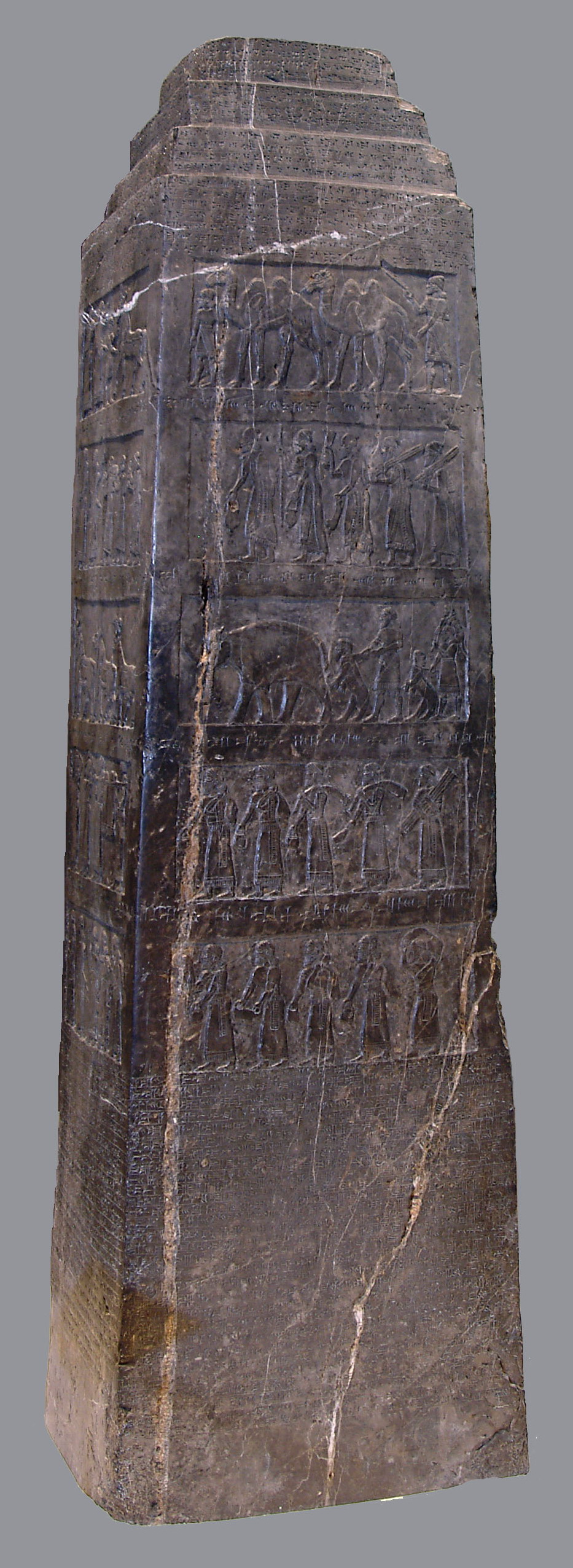Annals Edition 4 – The Black Obelisk, 828 or 827 BCE
Israel submits to Assyria
“The tribute of Jehu (Ia-ú-a), son of Omri (Hu-sum-ri); I received from him silver, gold, a golden saplu-bowl, a golden vase with pointed bottom, golden tumblers, golden buckets, tin, a staff for a king, (and) wooden puruhtu.”
Date- 828 or 827 BCE
Current Location- British Museum, London, England (BM 118885)
Language and Script- Assyrian?; cuneiform
Biblical Verses- 2 Kings 9–10
General Information- One of the most renowned artifacts from ancient Assyria is Shalmaneser III’s Black Obelisk, a four-sided black alabaster stele standing over six feet tall. At its apex is the resemblance of an ancient stepped ziggurat. Below that is a section of reliefs sandwiched between an edition of Shalmaneser’s annals. There are five registers of reliefs, which depict scenes of various foreign rulers bringing tribute to Shalmaneser, each with a caption above it. This edition of his annals goes through his 31st regnal year, or 828 BCE. We do not know what event the obelisk was commissioned to commemorate because the inscription lacks one of the usual concluding formulae. The engraver may have simply run out of room.
Relevance to Ancient Israel- Although Jehu is not mentioned in the abbreviated earlier years of this edition of the annals, he is depicted in the reliefs. According to the epigraphs, they depict tributes from the following rulers (from top down)- Sua of Gilzanu, Jehu son of Omri, Egypt (no ruler specified), Marduk-apla-usur of Suhi, and Qarparunda of Patinu. The register captioned as Jehu shows a figure bringing tribute and bowing before Shalmaneser. If this illustration is in fact of Jehu and not his envoy, it would be the only extant image of an Ancient Israelite king made during that king’s lifetime.
Circumstances of Discovery and Acquisition- The Black Obelisk was discovered by Austen Henry Layard in 1846 at Shalmaneser’s palace in Kalah. Newspapers and periodicals, including the popular Illustrated London News, covered the arrival of Layard’s antiquities from Nimrud the late 1840s.
Translation- Epigraphs published in Layard, Inscriptions, Pl. 98. Translation- Luckenbill, AR, I, 590, 591, 593.
II
The tribute of Jehu (Ia-ú-a), son of Omri (Hu-sum-ri); I received from him silver, gold, a golden saplu-bowl, a golden vase with pointed bottom, golden tumblers, golden buckets, tin, a staff for a king, (and) wooden puruhtu.
III
The tribute of the country Musri; I received from him camels whose backs were doubled, a river ox (hippopotamus), a sakea-animal (rhinoceros), a susu-antelope, elephants, bazitu- (and) uqupu-monkeys.
V
The tribute of Karparunda from Hattina; I received from him silver, gold, tin, bronze, copper, sirihu-pots, ivory (and) ebony-wood.
See also-
The Annals of Shalmaneser III- Jehu’s Tribute (4 inscriptions)







you change the ckear meaning to false one